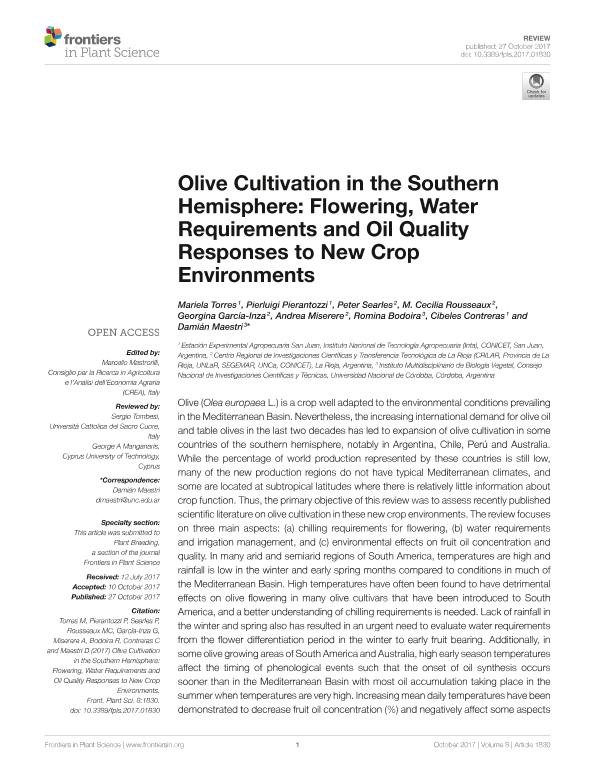Artículo
Olive cultivation in the southern hemisphere: flowering, water requirements and oil quality responses to new crop environments
Torres, Mariela Analía ; Pierantozzi, Pierluigi
; Pierantozzi, Pierluigi ; Searles, Peter Stoughton
; Searles, Peter Stoughton ; Rousseaux, Maria Cecilia
; Rousseaux, Maria Cecilia ; García Inza, Georgina Paula
; García Inza, Georgina Paula ; Miserere, Andrea
; Miserere, Andrea ; Bodoira, Romina Mariana
; Bodoira, Romina Mariana ; Contreras Valentín, Ana Cibeles
; Contreras Valentín, Ana Cibeles ; Maestri, Damian
; Maestri, Damian
 ; Pierantozzi, Pierluigi
; Pierantozzi, Pierluigi ; Searles, Peter Stoughton
; Searles, Peter Stoughton ; Rousseaux, Maria Cecilia
; Rousseaux, Maria Cecilia ; García Inza, Georgina Paula
; García Inza, Georgina Paula ; Miserere, Andrea
; Miserere, Andrea ; Bodoira, Romina Mariana
; Bodoira, Romina Mariana ; Contreras Valentín, Ana Cibeles
; Contreras Valentín, Ana Cibeles ; Maestri, Damian
; Maestri, Damian
Fecha de publicación:
10/2017
Editorial:
Frontiers
Revista:
Frontiers in Plant Science
e-ISSN:
1664-462X
Idioma:
Inglés
Tipo de recurso:
Artículo publicado
Clasificación temática:
Resumen
Olive (Olea europaea L.) is a crop well adapted to the environmental conditions prevailing in the Mediterranean Basin. Nevertheless, the increasing international demand for olive oil and table olives in the last two decades has led to expansion of olive cultivation in some countries of the southern hemisphere, notably in Argentina, Chile, Perú and Australia. While the percentage of world production represented by these countries is still low, many of the new production regions do not have typical Mediterranean climates, and some are located at subtropical latitudes where there is relatively little information about crop function. Thus, the primary objective of this review was to assess recently published scientific literature on olive cultivation in these new crop environments. The review focuses on three main aspects: (a) chilling requirements for flowering, (b) water requirements and irrigation management, and (c) environmental effects on fruit oil concentration and quality. In many arid and semiarid regions of South America, temperatures are high and rainfall is low in the winter and early spring months compared to conditions in much of the Mediterranean Basin. High temperatures have often been found to have detrimental effects on olive flowering in many olive cultivars that have been introduced to South America, and a better understanding of chilling requirements is needed. Lack of rainfall in the winter and spring also has resulted in an urgent need to evaluate water requirements from the flower differentiation period in the winter to early fruit bearing. Additionally, in some olive growing areas of South America and Australia, high early season temperatures affect the timing of phenological events such that the onset of oil synthesis occurs sooner than in the Mediterranean Basin with most oil accumulation taking place in the summer when temperatures are very high. Increasing mean daily temperatures have been demonstrated to decrease fruit oil concentration (%) and negatively affect some aspects of oil quality based on both correlative field studies and manipulative experiments. From a practical standpoint, current findings could be used as approximate tools to determine whether the temperature conditions in a proposed new growing region are appropriate for achieving sustainable oil productivity and quality.
Archivos asociados
Licencia
Identificadores
Colecciones
Articulos(CRILAR)
Articulos de CENTRO REGIONAL DE INV. CIENTIFICAS Y TRANSFERENCIA TECNOLOGICA DE ANILLACO
Articulos de CENTRO REGIONAL DE INV. CIENTIFICAS Y TRANSFERENCIA TECNOLOGICA DE ANILLACO
Articulos(IMBIV)
Articulos de INST.MULTIDISCIPL.DE BIOLOGIA VEGETAL (P)
Articulos de INST.MULTIDISCIPL.DE BIOLOGIA VEGETAL (P)
Articulos(SEDE CENTRAL)
Articulos de SEDE CENTRAL
Articulos de SEDE CENTRAL
Citación
Torres, Mariela Analía; Pierantozzi, Pierluigi; Searles, Peter Stoughton; Rousseaux, Maria Cecilia; García Inza, Georgina Paula; et al.; Olive cultivation in the southern hemisphere: flowering, water requirements and oil quality responses to new crop environments; Frontiers; Frontiers in Plant Science; 8; 10-2017; 1-12
Compartir
Altmétricas



